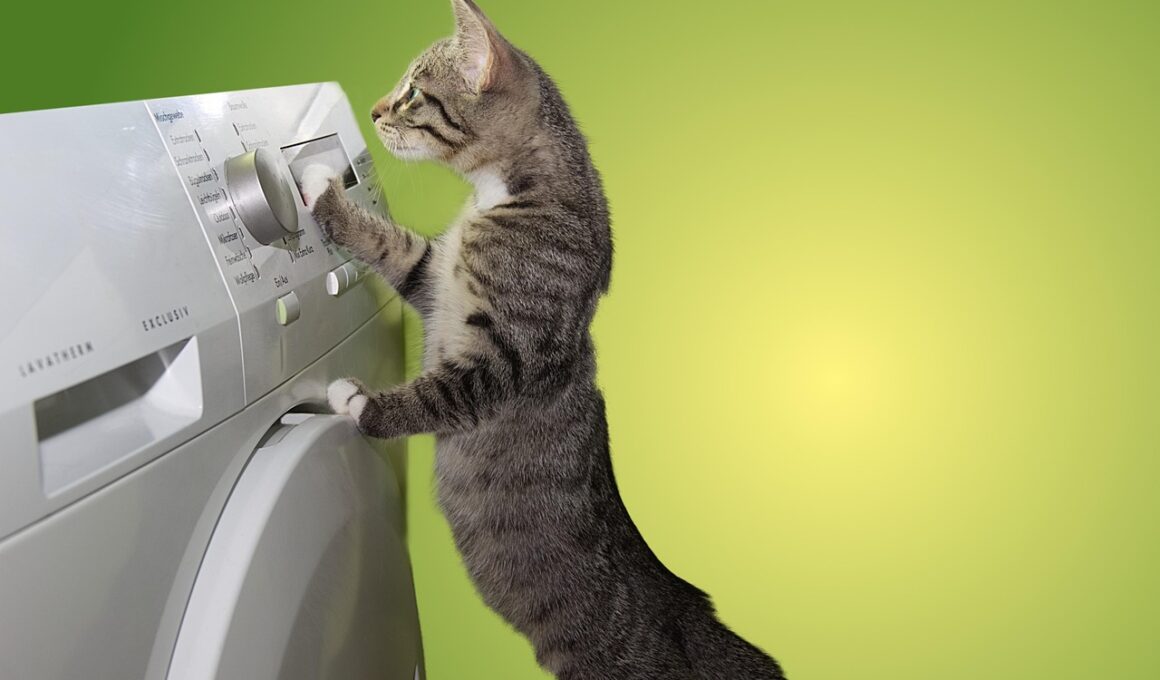Positive Reinforcement Techniques for Multi-Cat Households
Managing relationships in a multi-cat household can be complex. It requires understanding cat psychology, particularly using positive reinforcement techniques. These techniques help foster a harmonious environment among your feline friends. Positive reinforcement involves rewarding desired behaviors instead of punishing unwanted ones. By understanding the unique personalities of your cats, you can create an environment that fosters healthy behavior. It’s crucial to observe and recognize what motivates each cat. For example, while some favor treats, others might enjoy extra attention or playtime. Learning these preferences allows you to tailor your approach to meet the needs of each cat. Furthermore, consistency is essential; reward the good behavior immediately to reinforce the action effectively. This method not only encourages positive behaviors but also builds trust among your cats. As you implement these techniques, be patient and observant. Every cat is an individual, and progress might take time. Creating a peaceful multi-cat home requires effort, but positive reinforcement can make it a rewarding experience for both you and your cats.
Understanding Individual Cat Personalities
One of the keys to successful positive reinforcement in multi-cat households is understanding each cat’s distinct personality. Cats can be socially dominant or shy; hence their reactions to rewards may differ. For instance, a more assertive cat may respond well to food rewards, while a timid cat might be scared of this approach. Getting to know your cats’ likes and dislikes enables you to identify the most effective reinforcement method. Take the time to observe their behavior; do they prefer interactive play or quiet cuddles? Every cat thrives differently, and understanding these nuances is essential for applying positive reinforcement effectively. Additionally, establishing a routine can help your cats feel secure, as they know what to expect. Routines can reduce anxiety and uncertainty, making rewarding good behavior easier. By minimizing distractions during training sessions, you can help your cats focus better. Incorporating fun activities and engaging each cat uniquely fosters a positive atmosphere. Ultimately, this individualized approach enhances the effectiveness of your positive reinforcement training and builds stronger relationships with your feline companions.
Creating a positive environment is also influenced by your home setup. Multi-cat households benefit from designated areas where each cat can retreat when feeling overwhelmed. Providing multiple feeding stations, litter boxes, and resting areas can help reduce competition and stress among cats. This separation encourages good behavior and reduces unwanted conflicts, allowing each pet to thrive. Each cat should also have access to toys and enrichment opportunities tailored to their interests. Rotate toys regularly to maintain enthusiasm and engagement. Additionally, engaging cats in play together fosters teamwork and cooperation rather than rivalry. Group play sessions using interactive toys might help build bonds among your cats as they learn to work together for rewards. Monitor their interactions during playtime and guide them towards positive behavior to reinforce the teamwork concept. This approach not only provides physical exercise but also mental stimulation. Besides structured play, encouraging exploratory behaviors in your environment can demonstrate trust and autonomy. By fostering a sense of security in their environment through thoughtful setup, the frequency of positive encounters increases, strengthening the bond among all the cats.
Utilizing Treats and Toys as Rewards
When implementing positive reinforcement, selecting effective rewards like treats and toys plays a crucial role. Using high-value treats can motivate your cats to display desired behaviors reliably. Experiment with various kinds of treats to discover what excites them most. Some cats may prefer small bites, while others may enjoy crunchy treats or soft chews. The key is to choose rewards that make your cat eager to engage. Additionally, toys can serve as a great positive reinforcement tool. Toys that mimic prey, such as feather wands and laser pointers, can energize your cat while reinforcing positive actions. Once you’ve identified the most enticing rewards, timing becomes essential. Offer rewards immediately after the desired behavior occurs to create a clear connection between the action and the reinforcement. Don’t forget to encourage interactions with toys or games in a non-competitive way, as competition can lead to stress. Gradually increase the difficulty of the task or behavior to keep your cats challenged, maintaining their interest and promoting continual success in your training regimen.
In multi-cat households, creating structured training sessions can enhance the effectiveness of positive reinforcement. Short, frequent training sessions tend to be more successful than lengthy ones. Your cats will have better focus and remain engaged with short bursts of learning. Aim for five to ten-minute sessions several times a week. Consistency in your training routine is crucial; maintain similar timing and formats to help your cats know what to expect. Use visual cues, like hand signals or sounds, to help your cats link rewards with the desired behavior. Given that cats are adept learners, they respond well to clear instructions. Keeping the training atmosphere calm and positive is essential; loud noises or sudden movements may disrupt their focus and cause anxiety. Always end each session on a positive note, concluding with a reward or playtime, regardless of the outcome. Offering a reward consistently, even for small accomplishments, reinforces confidence and willingness to participate in future activities. This approach helps establish a strong training foundation, ensuring that each cat feels valued and understood in the household.
Addressing Conflicts with Reinforcement
Even with the best positive reinforcement techniques, conflicts may occasionally occur in multi-cat households. When disputes arise, it is important to approach them calmly. Acknowledge the cats’ behavioral cues to identify the root causes of their conflicts. Often, miscommunication or competition can lead to misunderstandings or aggressive encounters. Rather than focusing solely on reprimanding unwanted behavior, utilize positive reinforcement to encourage conflict resolution methods. For instance, rewarding a cat for redirecting its attention to a toy rather than engaging with an upset feline can be advantageous. Employing distractions during aggressive moments, such as tossing a toy or using treats to divert attention, helps mitigate the situation. Additionally, providing positive reinforcement for calm behavior post-conflict is crucial. This lets your cats learn that peaceful resolutions lead to enjoyable outcomes. Over time, with practice and patience, you can help establish a more tolerant, cooperative atmosphere among your cats. Moreover, establishing safe zones for each cat can help prevent conflicts by allowing each one to escape when they feel stressed or need a break.
Monitoring your cats’ behaviors while practicing positive reinforcement is vital for success. Keeping a journal of your training sessions can help track progress and identify patterns in behavior. Recording times, locations, and outcomes enables tailored adjustments to your approach based on observed behaviors. Along with noting rewards that yield the best results, you can fine-tune your methods over time. Additionally, consider employing video recordings during training sessions for further analysis. Reviewing these recordings may highlight details often missed in real-time; such insights can refine your techniques considerably. Ensure that each cat’s individuality is acknowledged regarding reinforcement methods. Tailor rewards based on changing interests, adjusting them as your cats evolve. Monitoring their behaviors can also identify emerging issues early, allowing for prompt intervention. Regular evaluation ensures that strategies remain effective and that your cats continue to feel supported. Consequently, as a pet owner, you’ll develop a deeper understanding of your cats’ emotions, promoting better relationships and contributing to a happy, well-adjusted multi-cat home.


